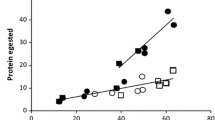Summary
Interactions between quaking aspen (Populus tremuloides) and the forest tent caterpillar (Malacosoma disstria) are likely to be influenced by leaf protein and phenolic glycoside levels, and insect detoxication activity. We investigated the direct and interactive effects of dietary protein and phenolic glycosides on larval performance and midgut enzyme activity of forest tent caterpillars. We conducted bioassays with six artificial diets, using both first and fourth stadium larvae. Four of the diets comprised a 2×2 factorial design-two levels of protein, each with and without phenolic glycosides. Additionally, we assayed high protein diets containing S,S,S-tributylphosphorotrithioate (DEF, an esterase inhibitor) and DEF plus phenolic glycosides. Enzyme solutions were prepared from midguts of sixth instars and assayed for β-glucosidase, esterase and glutathione transferase activities. First instar mortality and development times were higher for larvae on diets low in protein or containing phenolic glycosides. Effects of phenolic glycosides were especially pronounced at low protein levels and when administered with DEF. Fourth instar development times were prolonged, and growth rates reduced, in response to consumption of low protein diets. Effects of phenolic glycosides on growth were less pronounced, although the effect for larvae on the low protein diet was nearly significant. Activity of each of the enzyme systems was reduced in larvae reared on low protein diets, and esterase activity was induced in larvae fed phenolic glycosides. Our results suggest that larval performance may be strongly affected by levels of protein and phenolic glycosides commonly occurring in aspen foliage, and that these factors may play a role in differential defoliation of aspen by forest tent caterpillars.
Similar content being viewed by others
References
Batzer HO, Morris RC (1978) Forest tent caterpillar. USDA, Forest Service, Forest Insect and Disease Leaflet 9:1–8
Brattsten LB (1987) Metabolic insecticide defenses in the boll weevil compared to those in a resistance-prone species. Pest Biochem Physiol 27:1–12
Bryant JP, Clausen TP, Reichardt PB, McCarthy MC, Werner RA (1987) Effect of nitrogen fertilization upon the secondary chemistry and nutritional value of quaking aspen (Populus tremuloides Michx) leaves for the large aspen tortrix (Choristoneura conflictana (Walker)). Oecologia 73:513–517
Cohen E (1986) Glutathione-S-transferase activity and its induction in several strains of Tribolium castaneum. Ent Exp Appl 41:39–44
Duncan DP, Hodson AC (1958) Influence of the forest tent caterpillar upon the aspen forests of Minnesota. For Sci 4:71–93
Grisdale D (1985) Malacosoma disstria. In: Singh P, Moore RF (eds) Handbook of Insect Rearing, Vol 2. Elsevier, New York, pp 369–379
Hodson AC (1941) An ecological study of the forest tent caterpillar, Malacosoma disstria Hubn, in northern Minnesota. Univ Minn Agr Exp Stat Tech Bull 148:1–55
James TDW, Smith DW (1978) Seasonal changes in the major ash constituents of leaves and some woody components of trembling aspen and red osier dogwood. Can J Bot 56:1798–1803
Jao LT, Casida JE (1974) Insect pyrethroid-hydrolyzing esterases. Pest Biochem Physiol 4:465–472
Lindroth RL (1988) Hydrolysis of phenolic glycosides by midgut β-glucosidases in Papilio glaucus subspecies. Insect Biochem 8:789–792
Lindroth RL (1989a) Biochemical detoxication: mechanism of differential tiger swallowtail tolerance to phenolic glycosides. Oecologia 81:219–224
Lindroth RL (1989b) Host plant alteration of detoxication activity in Papilio glaucus glaucus. Ent Exp Appl 50:29–35
Lindroth RL (1989c) Differential esterase activity in Papilio glaucus subspecies: absence of cross-resistance between allelochemicals and insecticides. Pest Biochem Physiol 35:185–191
Lindroth RL, Hemming JDC (1990) Responses of the gypsy moth (Lepidoptera: Lymantriidae) to tremulacin, an aspen phenolic glycoside. Environ Entomol 19:842–847
Lindroth RL, Weisbrod AV (1991) Genetic variation in response of the gypsy moth to aspen phenolic glycosides. Biochem Syst Ecol (in press)
Lindroth RL, Scriber JM, Hsia MTS (1986) Differential responses of tiger swallowtail subspecies to secondary metabolites from tulip tree and quaking aspen. Oecologia 70:13–19
Lindroth RL, Hsia MTS, Scriber JM (1987) Seasonal patterns in the phytochemistry of three Populus species. Biochem Syst Ecol 15:681–686
Lindroth RL, Scriber JM, Hsia MTS (1988) Chemical ecology of the tiger swallowtail: mediation of host use by phenolic glycosides. Ecology 69:814–822
Lindroth RL, Anson BD, Weisbrod AV (1990) Effects of dietary protein and juglone on the gypsy moth: growth performance and detoxication enzyme activity. J Chem Ecol 16:2533–2547
Lindroth RL, Barman MA, Weisbrod AV (1991) Nutritional deficiencies in the gypsy moth, Lymantria dispar: effects on larval performance and detoxication enzyme activities. J Insect Physiol (in press)
Schacterle GR, Pollack RL (1973) A simplified method for quantitative assay of small amounts of protein in biologic material. Anal Biochem 51:654–655
Scriber JM (1977) Limiting effects of low leaf-water content on the nitrogen utilization, energy budget, and larval growth of Hyalophora cecropia (Lepidoptera: Saturniidae). Oecologia 28:269–287
Scriber JM, Slansky Jr F (1981) The nutritional ecology of immature insects. Ann Rev Ent 26:183–211
Scriber JM, Lindroth RL, Nitao J (1989) Differential toxicity of a phenolic glycoside from quaking aspen to Papilio glaucus butterfly subspecies, hybrids and backcrosses. Oecologia 81:186–191
Slansky F, Feeny P (1977) Stabilization of the rat of nitrogen accumulation by larvae of the cabbage butterfly on wild and cultivated food plants. Ecol Monogr 47:209–228
Slansky F, Wheeler GS (1989) Compensatory increases in food consumption and utilization efficiencies by velvetbean caterpillars mitigate impact of diluted diets on growth. Ent Exp Appl 51:175–187
Waldbauer GP (1968) The consumption and utilization of food by insects. Adv Insect Physiol 5:229–288
Author information
Authors and Affiliations
Rights and permissions
About this article
Cite this article
Lindroth, R.L., Bloomer, M.S. Biochemical ecology of the forest tent caterpillar: responses to dietary protein and phenolic glycosides. Oecologia 86, 408–413 (1991). https://doi.org/10.1007/BF00317609
Received:
Accepted:
Issue Date:
DOI: https://doi.org/10.1007/BF00317609




